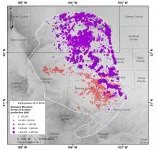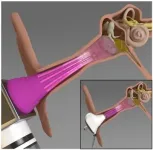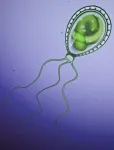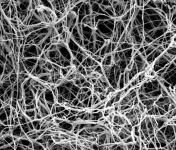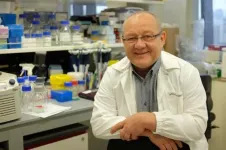(Press-News.org) Boulder, Colo., USA: Subsurface carbon sequestration--storing carbon in
rocks deep underground--offers a partial solution for removing carbon from
the atmosphere. Used alongside emissions reductions, geologic carbon
sequestration could help mitigate anthropogenic climate change. But like
other underground operations, it comes with risks--including earthquakes.
Geophysicists are still working to understand what can trigger
human-induced earthquakes, which have been documented since the 1960s. A
new study, published in Geology on Thursday, explores why part of
a heavily produced oilfield in the U.S. has earthquakes, and part of it
doesn't. For the first time, the authors demonstrate that the influence of
past oil drilling changes stresses on faults in such a way that injecting
fluids is less likely to induce, or trigger, earthquakes today.
The study focuses on the Delaware Basin, an oil- and gas-producing field
spanning the border between West Texas and New Mexico. Drilling there has
taken place since at least the 1970s, with over 10,000 active individual
wells dotting the region. There, Stanford geophysicists No'am Dvory and
Mark Zoback noticed an interesting pattern in seismic activity. Recent
shallow earthquakes were mostly located in the southern half of the basin,
while the northern half is seismically quiet, despite shallow wastewater
injection occurring across the basin.
"The compelling question, then, is why are all the shallow earthquakes
limited to one area and not more widespread?" Zoback says.
Earthquakes can be induced by injecting fluids like wastewater underground.
When wastewater is injected into the rocks, pressures increase, putting the
rocks and any faults that are present under higher stress. If those
pressures and stresses get high enough, an earthquake can happen.
Earthquakes from injection in the southern Delaware Basin tend to be
shallow and relatively low-magnitude, typically strong enough to rattle the
dishes, but not enough to cause damage. However, if deeper faults are
activated, higher-magnitude earthquakes can occur and cause damage. For
example, in March 2020, a magnitude 4.6 earthquake rumbled in Mentone,
Texas, likely due to deep injection that interacted with faults in the
crystalline basement rock around five miles belowground.
"The size of an earthquake is limited by the size of the fault that slips,"
Dvory explains. Where faults are shallow and small (just a few kilometers
in size), quake magnitudes tend to be small. "You can still feel it, but
it's less dangerous."
Minimizing the risk of earthquakes is a goal for any subsurface operation,
whether it's oil and gas production or carbon sequestration. That made the
Delaware Basin, with its odd pattern of earthquakes, a great target for
Dvory and Zoback. It was a natural experiment in geomechanics, the "why"
behind induced earthquakes.
To decipher the pattern, Dvory and Zoback first modeled the underground
pressures needed to cause faults in the basin to slip and connected those
values to estimated stress values. Once they had established that baseline,
they calculated the pore pressures around the Delaware Basin. Their results
showed a clear pattern: geologic formations in the northern basin where
hydrocarbons had previously been produced had lower pore pressures than in
"unperturbed" rock, and there were no earthquakes. The southern basin,
which had almost no previous production from the same formations, had
higher initial pressures and earthquakes.
"In some areas we have evidence of oil and gas development from even the
1950s," Dvory says. "Where there was significant hydrocarbon production,
pressure was depleted, and the formations essentially became more stable."
Now, when fluids are injected back into those 'stable,' previously drilled
rocks, the starting pressure is lower than the first time they were
drilled.
"So where oil production occurred previously, current injection results in
significantly lower pressure such that it's much less likely to trigger
earthquakes," Zoback explains. "It's not inconceivable that at some point,
if you injected enough, you could probably cause an earthquake. But here in
the area we study, we are able to document that what happened previously
strongly affects how current operational processes affect the likelihood of
earthquake triggering."
Targeting these sites of past oil production, with their lower earthquake
risk, could be a good approach for carbon sequestration.
"We have a global challenge to store enormous volumes of carbon dioxide in
the subsurface in the next ten to twenty years," Zoback says. "We need
places to safely store massive volumes of carbon dioxide for hundreds of
years, which obviously includes not allowing pressure increases to trigger
earthquakes. The importance of geoscience in meeting this challenge can't
be overstated. It's an enormous problem, but geoscience is the critical
place to start."
FEATURED ARTICLE
Prior oil and gas production can limit the occurrence of
injection-induced seismicity: A case study in the Delaware Basin of
western Texas and southeastern New Mexico, USA
Noam Z. Dvory; Mark D. Zoback
Author contact: Noam Z. Dvory, nzd@stanford.edu
https://pubs.geoscienceworld.org/gsa/geology/article-abstract/doi/10.1130/G49015.1/604590/Prior-oil-and-gas-production-can-limit-the
INFORMATION:
GEOLOGY articles are online at
https://geology.geoscienceworld.org/content/early/recent
. Representatives of the media may obtain complimentary articles by
contacting Kea Giles at the e-mail address above. Please discuss articles
of interest with the authors before publishing stories on their work, and
please make reference to GEOLOGY in articles published. Non-media requests
for articles may be directed to GSA Sales and Service,
gsaservice@geosociety.org.
https://www.geosociety.org
Middle ear infections, also known as otitis media, affect more than 80% of the children in the U.S. In a new study, researchers have designed a miniaturized 3D-printed device to inactivate Pseudomonas aeruginosa, a common bacterium that causes the infection.
The device--a microplasma jet array--generates plasma, which is composed of charged particles and reactive molecules that have been previously shown to inactivate various pathogens. "This is the first time anyone has tried treating middle ear infections using plasma technology," said Jungeun Won, a graduate student in the Boppart lab. "Usually, the treatment involves using ...
HUNTINGTON, W.Va. - According to researchers at Marshall University, a maternal diet rich in Omega-3 fatty acids protects from breast cancer development in offspring. In a new study recently published by Frontiers in Cell and Developmental Biology, researchers noted a significant difference in mice from mothers that were fed a diet rich in canola oil, compared with mothers fed a diet rich in corn oil. A maternal Omega 3-rich diet affected genome-wide epigenetic landscape changes in offspring and potentially modulated gene expression patterns.
Dr. Ata Abbas, a former postdoctoral research fellow in Marshall's Department of Biological Sciences, headed a research team under the leadership ...
New Brunswick, N.J. (June 28, 2021) - A Rutgers-led study sheds new light on the evolution of photosynthesis in plants and algae, which could help to improve crop production.
The paper appears in the journal New Phytologist.
The scientists reviewed research on the photosynthetic amoeba Paulinella, which is a model to explore a fundamental question about eukaryote evolution: why was there a single origin of algae and plants? That is, why did photosynthesis by primary plastid endosymbiosis not originate multiple times in the tree of life?
Photosynthesis is the process by which plants and other organisms use sunlight to synthesize ...
A first-of-its-kind longitudinal study of infant curiosity found that months-old babies most captivated by magic tricks became the most curious toddlers, suggesting a pre-verbal baby's level of interest in surprising aspects of the world remains constant over time and could predict their future cognitive ability.
"Something about a baby's curiosity about magic tricks is predicting how curious they become as preschoolers," said Lisa Feigenson, co-director of the Johns Hopkins University Laboratory for Child Development. "What the data suggest is that some three-year-olds have a leg up or seem particularly well positioned to learn a lot about the world."
The findings appear today in Proceedings of the National Academy of Sciences.
Until this study, little was known about curiosity ...
New Brunswick, N.J. (June 28, 2021) - COVID-19's socio-economic effects will likely cause another severe production crisis in the coffee industry, according to a Rutgers University-led study.
The study, which appears in the journal Proceedings of the National Academy of Sciences, included researchers from the University of Arizona, University of Hawaii at Hilo, CIRAD, Santa Clara University, Purdue University West Lafayette and University of Exeter.
"Any major impacts in the global coffee industry will have serious implications for millions of people across the globe, including the coffee retail ...
An Australian mammal thought to have been wiped out over 150 years ago can now be crossed off our list of extinct animals, following a new study.
Researchers compared DNA samples fromeight extinct Australian rodents, as well as 42 of their living relatives, to look at the decline of native species since the arrival of Europeans in Australia.
The study showed the extinctGould's mouse was indistinguishable from the Shark Bay mouse, still found on several small islands off the coast of Western Australia.
According to lead author Dr Emily Roycroft ...
Scientists have made a breakthrough in understanding the process that leads to a blood clot forming in the lungs - a condition that kills more than two thousand people in the UK each year.
The clot forms a pulmonary embolism or blockage, cutting off blood flow to major blood vessels in the lungs.
In many cases, the blockage is caused by fragments that have broken away from a blood clot elsewhere in the body, such as a deep vein thrombosis in one of the legs. The fragments are transported to the lungs via the blood stream.
In a paper published today (28 June) in the scientific ...
The billions of microbes living in your gut could play a key role in supporting the formation of new nerve cells in the adult brain, with the potential to possibly prevent memory loss in old age and help to repair and renew nerve cells after injury, an international research team spanning Singapore, UK, Australia, Canada, US, and Sweden has discovered.
The international investigating team led by Principal Investigator Professor Sven Pettersson, National Neuroscience Institute of Singapore, and Visiting Professor at Lee Kong Chian School of Medicine, Nanyang Technological University, Singapore (NTU Singapore), and Sunway University, Malaysia, found that gut microbes that metabolise tryptophan - an essential amino acid - secrete small molecules called ...
Researchers from Tallinn University of Technology, Grete Raba, Signe Adamberg, and Kaarel Adamberg showed that an acidic environment enhances the production of butyric acid from apple pectin by faecal bacterial consortia - microbiota. Pectin is a dietary fibre abundant in apples, berries, fruits, and vegetables. Pectin is used in jellies and desserts. As human digestive enzymes are not able to degrade pectin, it is metabolized by the microbes of the large intestine. The main conclusions of the research, published in FEMS Microbiology Letters, was the importance of environmental acidity (pH) on the composition and metabolism of colon bacteria. The colonic pH is, however, strongly related to one's diet.
Fibre-rich diets that contain plenty of whole-grain ...
A connective tissue protein known to support the framework of organs also encourages immune responses that fight bacterial infections, while restraining responses that can be deadly in the condition called sepsis, a new study finds.
Led by researchers from NYU Grossman School of Medicine, the work revolves around the extracellular matrix (ECM) of connective tissues, once thought of as an inert framework that shapes bodily compartments, but increasingly recognized as a signaling partner with nearby cells in normal function, and a contributor to disease when signals go awry. Among the key players in the ECM are fibroblasts, the cells that make tough structural matrix proteins ...
